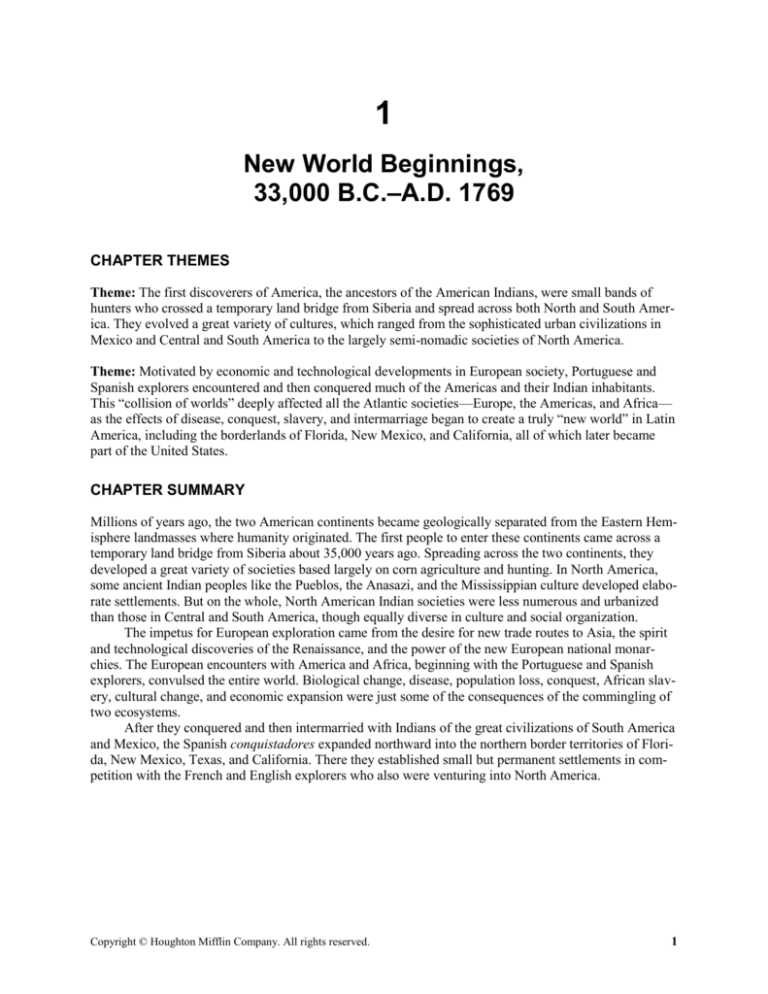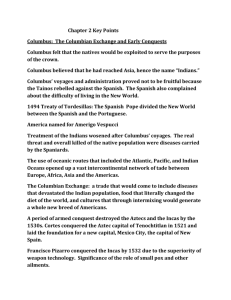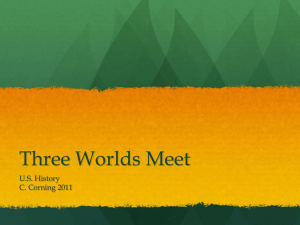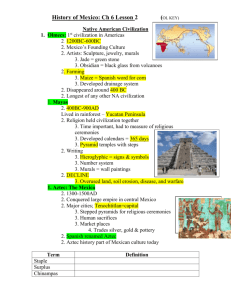
1
New World Beginnings,
33,000 B.C.–A.D. 1769
CHAPTER THEMES
Theme: The first discoverers of America, the ancestors of the American Indians, were small bands of
hunters who crossed a temporary land bridge from Siberia and spread across both North and South America. They evolved a great variety of cultures, which ranged from the sophisticated urban civilizations in
Mexico and Central and South America to the largely semi-nomadic societies of North America.
Theme: Motivated by economic and technological developments in European society, Portuguese and
Spanish explorers encountered and then conquered much of the Americas and their Indian inhabitants.
This “collision of worlds” deeply affected all the Atlantic societies—Europe, the Americas, and Africa—
as the effects of disease, conquest, slavery, and intermarriage began to create a truly “new world” in Latin
America, including the borderlands of Florida, New Mexico, and California, all of which later became
part of the United States.
CHAPTER SUMMARY
Millions of years ago, the two American continents became geologically separated from the Eastern Hemisphere landmasses where humanity originated. The first people to enter these continents came across a
temporary land bridge from Siberia about 35,000 years ago. Spreading across the two continents, they
developed a great variety of societies based largely on corn agriculture and hunting. In North America,
some ancient Indian peoples like the Pueblos, the Anasazi, and the Mississippian culture developed elaborate settlements. But on the whole, North American Indian societies were less numerous and urbanized
than those in Central and South America, though equally diverse in culture and social organization.
The impetus for European exploration came from the desire for new trade routes to Asia, the spirit
and technological discoveries of the Renaissance, and the power of the new European national monarchies. The European encounters with America and Africa, beginning with the Portuguese and Spanish
explorers, convulsed the entire world. Biological change, disease, population loss, conquest, African slavery, cultural change, and economic expansion were just some of the consequences of the commingling of
two ecosystems.
After they conquered and then intermarried with Indians of the great civilizations of South America
and Mexico, the Spanish conquistadores expanded northward into the northern border territories of Florida, New Mexico, Texas, and California. There they established small but permanent settlements in competition with the French and English explorers who also were venturing into North America.
Copyright © Houghton Mifflin Company. All rights reserved.
1
2
Chapter 1
DEVELOPING THE CHAPTER: SUGGESTED LECTURE OR DISCUSSION TOPICS
Using globes and maps, examine the impact of geology and geography on the prehistory and history of the Americas. Point out the areas of relatively dense Indian population and civilization before
1492, and emphasize the ways in which geography shaped the subsequent pattern of European exploration and conquest—in both South and North America.
REFERENCE:
D. W. Meinig, The Shaping of America: A Geographical Perspective on 500 Years of
Atlantic America (1986).
Explore what has been learned from history, anthropology, and archaeology regarding the life of
American Indians before 1492. Emphasize that these societies were varied and dynamic, and had
undergone significant conflicts and changes over many centuries. Perhaps select one North American Indian culture that had disappeared by the time of the Columbian encounter (e.g., the Anasazi
culture that built Mesa Verde and Chaco Canyon in the Southwest), and compare their ways of life
with those of the Indians that the Europeans first met when they arrived.
REFERENCE:
Brian M. Fagan, Kingdoms of Gold, Kingdoms of Jade: The Americas Before Colum-
bus (1991).
Analyze in more depth the condition of European societies at the beginning of the age of exploration. Consider, for example, the ways in which Europe was still “medieval” in its outlook around
1500 or so, and the ways in which it was being affected by more “modern” developments. Point out
the changes in Europe that were occurring almost simultaneously with the age of discovery—
particularly the Protestant Reformation and Catholic Counter-Reformation, the Italian Renaissance,
the unification of Spain, the reign of Henry VIII—and consider their impact on the Americas.
REFERENCE:
Immanuel Wallerstein, The Modern World-System (1974).
Discuss the “exchanges” involved in the encounter of Europeans, Native Americans, and Africans
in the New World. Focus particularly on the ways in which all parties in the process—the “conquerors” as well as the “conquered”—were changed. The emphasis could be on issues of population, intermarriage, agriculture, and the like, or on the new forms of society that developed in both
Hispanic America and North America as a result of the events of 1492 and after.
REFERENCES:
Karen Ordahl Kupperman, Settling with the Indians: The Meeting of English and Indian Cultures in America, 1580–1640 (1980); Ramon A. Gutierrez, When Jesus Came, The Corn
Mothers Went Away (1991).
FOR FURTHER INTEREST: ADDITIONAL CLASS TOPICS
Consider the whole story of the settlement and discovery of America from the Indians’ point of
view. Examine the controversies over Columbus’s role in the discovery and the actions of subsequent Spanish conquistadores.
Compare the development and subsequent history of the Spanish in Mexico with that of the English
in North America. Consider particularly the impact of the “mestizo factor” in Mexican history (a
result of the intermarriage of Spanish and Indians) compared to the quite different pattern of English relations with the Indians in North America.
Copyright © Houghton Mifflin Company. All rights reserved.
New World Beginnings, 33,000 B.C.—A.D. 1769
3
Discuss the different historical perspective obtained by considering the role of the Spanish borderlands of Florida, New Mexico, and California as part of the history of colonial America (as distinct
from examining only the later English settlements along the Atlantic coast). How does our understanding of American history alter if we consider developments in these areas to be of equal importance?
CHARACTER SKETCHES
Christopher Columbus (1451–1506)
Although his encounter with continents and peoples previously unknown to Europeans transformed world
history, Columbus, the Genoese sailor who discovered America for the Spanish monarchy, never really
understood the nature or significance of his accomplishment.
Having sailed under the flags of many nations, including Portugal, Columbus was already a wellknown, successful voyager when he became obsessed with the idea of reaching Cathay (China) and the
Indies by sailing west. His frustrating inability to gain backing for the venture ended when Ferdinand and
Isabella agreed to supply him three ships.
The great achievement of Columbus’s first voyage was not only to navigate unknown waters under
unprecedented conditions but to keep his crews from mutiny—especially when the ships were becalmed
after nearly sixty days. Although well aware during all his voyages that he was not in China or India, Columbus became firmly convinced that he had found islands just off the Asian coast and that the rich cities
of Japan and China were not far away. This notion was reinforced by his desperate need to obtain continuing funding from the Spanish rulers, who pressed ever harder for concrete economic gains from the
voyages.
Quote: “The inhabitants of this and of all the other islands I have found or gained intelligence of, both
men and women, go as naked as they were born, with the exception that some of the women cover one
part only with a single leaf or grass with a piece of cotton, made for that purpose…. I gave away a thousand good and pretty articles which I had brought with me in order to win their affection, and that they
might be led to become Christians, and be well inclined to love and serve their highnesses and the whole
Spanish nation….” (Letter on the first voyage, 1493)
REFERENCE: John
Stewart Wilford, The Mysterious History of Columbus (1991).
Moctezuma II (1466–1520)
Moctezuma II (also called Montezuma II) was the Aztec ruler who succumbed to Cortés’s invasion of
Mexico.
He was the tenth in the line of Aztec emperors who controlled the vast regions and diverse peoples
of Mexico from their rich capital at Tenochtitlán. Like other members of the royal aristocracy, he lived in
luxury and served as a high priest of the elaborate but cruel Aztec religion. He succeeded to the throne in
1502 on the death of his uncle Ahuitzotl.
Before Cortés arrived, Moctezuma had expanded the Aztec realm, yet controlling the increasingly
restless subordinate peoples of the empire demanded more and more of his energy. He was particularly
devoted to the god Huitzilpochtli, but also came under the influence of astrologers and readers of portents.
Their pessimistic predictions about his fate evidently weakened his will to resist the Spanish invaders.
Copyright © Houghton Mifflin Company. All rights reserved.
4
Chapter 1
After Cortés and his men seized Moctezuma and held him under house arrest, the people of Tenochtitlán became increasingly hostile to their leader. When Moctezuma appeared in public for the first
time in nearly a year in early 1520, the angry populace showered him with stones before he could retreat
indoors. The Spanish claimed that the wounded ruler died shortly thereafter from the stoning, but many
Aztecs believed that the Spanish killed him. The truth remains unknown.
Quote: “I have in truth seen you and have now set eyes upon your force. You have come between mists
and clouds, and now it has come to pass. Now you have arrived, with much fatigue and toil. Come to our
land, come and repose.” (Message to Cortés as he approached Tenochtitlán, 1519)
REFERENCE:
Hugh Thomas, Conquest: Montezuma, Cortes, and the Fall of Old Mexico (1994).
Hernán Cortés (1485–1547)
Like many conquistadores, Cortés was born into a noble family but as a younger son failed to inherit extensive lands and wealth. As a youth, he was restless, ambitious, and nearly uncontrollable. In 1504, at
age nineteen, he sailed for the island of Hispaniola (today’s Dominican Republic and Haiti), at that time
the headquarters of Spanish activity in the New World.
Cortés farmed and worked as a minor town official for six years, but he longed for greater adventures. In 1511, he joined a successful expedition to Cuba and then used a commission from the governor
of Cuba, Velazquez, to assemble an expedition of eleven ships, five hundred soldiers, and sixteen horses.
Although Velazquez soon changed his mind, Cortés had already sailed for Mexico. Cortés’s brilliant, if
treacherous, combination of military, political, and psychological tactics overcame Aztec resistance and
gained him an empire larger than Spain. His reports of his conquests, contained in five lengthy letters to
King Charles V of Spain, are full of fascinating detail, as well as much boasting and exaggeration.
Cortés was a talented administrator, but peaceful pursuits did not suit him, and in 1524 he headed
for Honduras in search of further glory. There, he succeeded only in ruining his health and undermining
his position in Mexico City. He retired to his estate in Cuernavaca, Mexico in 1528, and in 1540 returned
to Spain to die, a broken man.
Quote: “Touching Montezuma’s palace and all that was remarkable in his magnificence and power, there
is so much to describe that I do not know how to begin.…There could be nothing more magnificent than
that this barbarian lord should have all the things of heaven to be found under his domain, fashioned in
gold and silver and jewels and feathers.” (Second letter to King Charles V, 1521)
REFERENCE: Jon White,
Cortés and the Downfall of the Aztec Empire: A Study in the Conflict of Cultures,
rev. ed. (1989).
QUESTIONS FOR CLASS DISCUSSION
1. How did Indian societies of South and North America differ from European societies at the time the
two came into contact? In what ways did Indians retain a “world view” different from that of the Europeans?
2. What role did disease and forced labor (including slavery) play in the early settlement of America? Is
the view of the Spanish and Portuguese as especially harsh conquerors and exploiters valid—or is this
image just another version of the English “black legend” concerning the Spanish role in the Americas?
Copyright © Houghton Mifflin Company. All rights reserved.
New World Beginnings, 33,000 B.C.—A.D. 1769
5
3. Are the differences between Latin America and North America due primarily to the differences between the respective Indian societies that existed in the two places, or to the disparity between Spanish and English culture? What would have happened if the English had conquered densely settled
Mexico and Peru, and the Spanish had settled more thinly populated North America?
4. In what ways are the early (pre-1600) histories of Mexican and the present-day American Southwest
understood differently now that the United States is being so substantially affected by Mexican and
Latin American immigration and culture? How should this early history of Spanish colonization be
understood in relation to the later English settlement of the eastern seaboard?
MAKERS OF AMERICA: THE CONQUISTADORES
Questions for Class Discussion
1. Should the Spanish conquistadores be especially blamed for the cruelties and deaths (including those
by disease) inflicted on the original Indian populations of the Americas? Is it possible to make such
criticisms without falling into the traditional English fallacies of the “black legend”? (See text, p. 16)
2. What was the long-term significance for Latin America of the “immortality” achieved by the conquistadores through intermarriage with Indian women? How did the development of a large mestizo
population make Latin American history different from that of English North America?
Suggested Student Exercises
Examine the changing image of Christopher Columbus from the nineteenth century to the present.
Consider the altered perspectives on “Columbus Day” as an American national holiday.
Examine some visual portrayals of the conquests of Mexico and Peru from the past and present, and
compare how, over time, artists of various political outlooks have depicted the conquistadores and
their victims.
Copyright © Houghton Mifflin Company. All rights reserved.









